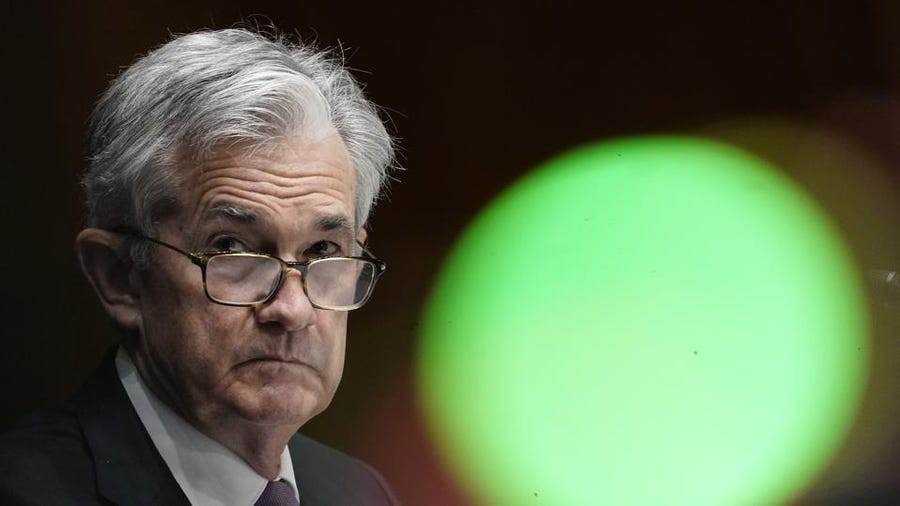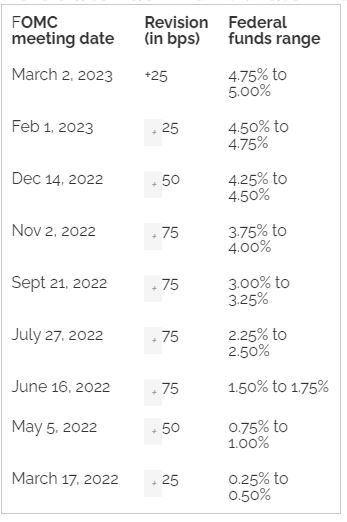Key Takeaways:
- The Fed will likely raise interest rates by another 25 bps in the 10th revision today.
- Powell is between a rock and a hard place.
- Experts say the Fed will not pivot and instead will follow historical patterns.

YEREVAN (CoinChapter.com) – The Federal Reserve adopted the hawkish quantitative tightening policy in 2022 to deal with runaway inflation. Thus, the lawmakers hiked up the interest rates nine times in the previous year, each revision ranging from 25 to 75 bps.

However, the question remains, will the Federal Open Market Committee (FOMC) meeting on May 3 approve the intended 25 bps hike in Q2?
The Fed is not likely to pivot from the targeted interest rate hikes.
The banking crisis unfolding since March 8 created an opposing incentive for the Fed. In detail, after the Silicon Valley Bank collapse, the lawmakers created an emergency fund to save the banking sector, which, Biden’s administration claimed, was not a bailout.
Thus, the Fed now has two roads to take: prioritize the battle against inflation and risk sending the economy into a recession, pivot on the interest rate hikes, inject liquidity to aid the banking crisis, and lose the grip on inflation.
Global X’s Portfolio Strategist (VP) Michelle Cluver agreed. She told CoinChapter that the Fed “walked a tightrope between being too restrictive in their focus on inflation and pivoting too early.”The expert also noted that if Powell pivoted too quickly, he would risk “establishing the perception that issues in the banking system are more systematic.”
Also read: Vladimir Putin faces arrest if he travels to South Africa for the BRICS summit.
The “Arthur Burns precedent” hints Powell will not budge
According to Claudia Sahm, a former Fed economist, several historical factors hint Powell will not pivot from the expected 25 bps rate hike. The “Arthur Burns precedent” was one of them.
In detail, Arthur Burns was the Fed Chair from 1970-78 and is now “widely regarded in mainstream circles as the worst Chair in living memory,” after pivoting on interest rate hikes when the unemployment rocketed. Sahm noted that a continued hike is not something the Fed SHOULD do, but rather something it WILL do.
We are taught monetary policy can do good in the world, but not if you do it as Burns did. Again, to avoid Burn’s legacy, one must not pivot when unemployment rises.
said Sahm.
Also read: U.S. Congress raises debt ceiling & cuts Government spending after Treasury Secretary Warns of economic catastrophe.
Conversely, Burns’ successor Paul Volcker (1979 to 1987), held high esteem in the establishment and had a “profound effect” on current Chair Jerome Powell. Volcker viewed such pivots as a “vacillation and procrastination” that carry “grave risks.” Moreover, Powell has already voiced his stance that the unemployment risk is a necessary evil to contain inflation.
Mizuho U.S. Chief Economist Steven Ricchiuto agreed with the hawkish outlook. He cited Powell’s previous speeches, where the Chair talked about why the Fed needed to proceed with the interest rate hikes despite the rise in the unemployment rate.
Ricchiuto also capitalized on the fact that Powell hoped to achieve a soft landing in the labor market and that a 25 bps rate hike and a subsequent pause are the most likely outcome of today’s FOMC meeting.


